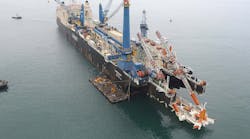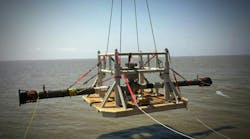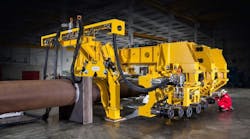When a polymer is placed into seawater at pressure, a number of things can happen. First, it can take in water and swell - a problem for rudder bearings on ships if the swell characteristics are not known correctly, but a benefit for new shape-changing polymers that can be used as actuators.
Second, the water taken in can react with constituent parts of the polymer or matrix to dissolve and remove them or it can react to cut the polymer chains (scission by hydrolysis) or it can move them apart so that the properties change (plasticization). Much depends not only on the makeup of the polymer, but also on how it is made - and that is a very important often-ignored fact.
An example is silicone rubber. This material is used in breast implants because of the high chemical stability, excellent flexibility, and compressibility. However, leaking of compounds containing silicone due to cutting of bonds within the material, enter the body. Also silicone rubber is used underwater for the same reasons that it is used for implants - in electrical connectors and as coatings.
Does the material suffer degradation in sea water? Yes, but it will usually be impossible to say how much. This is because most types of silicone rubber are designed for specific applications by adding various fillers to modify the properties of the pure material.
PEEK products
PEEK is a tough, thermally stable aromatic polymer that is among the most expensive on the market and was first commercialized by ICI as Victrex PEEK in 1982. As a single compound material without fillers, it is widely believed to be stable in seawater. However, this is not true.
The perception seems to have arisen because most of the published work on water effects is for immersion in pure water, not seawater. In seawater, the amount of water taken up is the same as for fresh water, but the effects are different. For a typical PEEK material (see accompany figure), the bending modulus reduces and the glass transition temperature is lowered. This implies both physical and chemical change, and it is irreversible.
- Physically: There is an increase in the free volume of the polymer that appears as plasticization
- Chemically: There is hydrolysis or cutting of some chains to break up the crystalline structure.
Composites
GRP or composite laminate structures are in increasing use - for example, as subsea protection covers. For marine structures, many resins can be used, but polyester resin is common for hand lay-up structures and vinyl ester resin for structures manufactured using infusion-molding processes.
Both resins are unsaturated, meaning they have to be cross-linked (cured) by use of a reactive monomer - usually styrene. Processes like Scrimp (the Seamann composites resin infusion molding process) allow greater fiber content, and usually better quality of the matrix than hand lay-up.
For GRP composites, seawater can cause hydrolysis, de-bonding of the fiber/resin interface and blistering. Hand lay-up produces a large number of trapped bubbles that make such composites even more sensitive to water uptake. The vinyl ester resin materials formed by infusion molding, therefore, tend to show very much less degradation by hydrolysis and fiber/matrix de-bonding than the polyester resin-based materials. Nevertheless, in our experience, GRP materials, no matter how they are made, usually show significant changes (increase) in modulus and glass transition temperature in use that point to deficiencies in curing of the original materials.
This implies that there is styrene monomer remaining in the material and that curing occurs over time. The effect can be very significant. We have found increases of 2-3% in the Log of the modulus. Where composite structures are used for impact resistance (as in subsea protection covers), the effect could be dramatic.
Thus, there are two major problems with composites in seawater - both caused in manufacture. One seems to affect most materials and that is a failure to cure all the reactive styrene monomer. The other is degradation that is typical of all polymers, but which appears in composites as de-bonding of the fibre/matrix interface.
Future problems
Average current operations downhole reach temperatures and pressures of the order of 150° C and 70-100 MPa. The challenge for the industry now is to access and operate wells where downhole conditions are likely to produce temperatures well in excess of 200° C and pressures of over 140 MPa. A limiting target might be 250° C and 170 MPa.
Little is known, however, about the effects of these parameters combined with the fluid environment on the durability of polymeric materials and there is no reason to expect the effects to be combined in a linear fashion. Nor is it clear that degradation will be by the same mechanisms that exist in less severe conditions. This has been highlighted by recent work that demonstrated the possibility of using PEEK in temperatures of up to around 140° C.
However, it also indicated problems in the selection and qualification of polymeric materials beyond this temperature and for pressures above 70 Mpa. This work, however, focused on commercial thermoplastics only, because of processing and manufacturing requirements. There is a need to broaden the range of materials studied to commercial thermosets and resins.
The project also demonstrated two other things - that these aging conditions are at the upper limit of the capability of state of the art, commercially available polymeric materials and that there is a short to medium-term requirement for novel high performance materials for downhole applications that will show a significant improvement in mechanical properties, thermal properties and chemical penetration resistance over existing materials.
The oil industry has been slow to recognize these needs. There has been reliance on equipment suppliers to supply products against exacting specifications, but no clear understanding of how this can be done or what to do if it cannot. Furthermore, the industry has not universally recognized that environmental protection changes that amount to an effective prohibition on the discharge of oil or synthetic oil-based drill fluids will fundamentally change the fluid environment of some wells.
Nearing limits?
Taking a longer-term view, existing polymers, may have reached limits on their capabilities. At the very least, and applying the 80/20 rule, it is a fact that development to meet higher specifications implies greater and greater effort. It appears from preliminary work that a strong candidate for a step change in capability to extend use, and perhaps, also to replace conventional materials would be the new and novel materials that are exfoliated-clay nanocomposites.
Work on polyethylene terephathalate (PET) clay nanocomposites showed that the inclusion of exfoliated clay in PET significantly improved its mechanical properties (the modulus of the nanocomposite was three times that of pure PET) and thermal properties (increase of the PET heat distortion temperature by up to 50
It is evident, from this brief review, that two areas of research are critical to the oil and gas industry's ability to drill and reliably operate deep and over-pressured reservoirs - understanding of the:
- Synergistic effect of the degradation parameters (pressure, temperature, fluids)
- Degradation mechanisms occurring in commercial polymeric materials currently used or projected for use in the industry.
This is critical for the sustainable and profitable operation of exploration and production systems currently available in the market. Development is necessary of new and novel materials that will be able to operate predictably in the more drastic environmental conditions encountered in more extreme reservoirs. This has been highlighted by the limitations of the commercial materials currently available.
Editor's Note: A list of references is available from the author.






